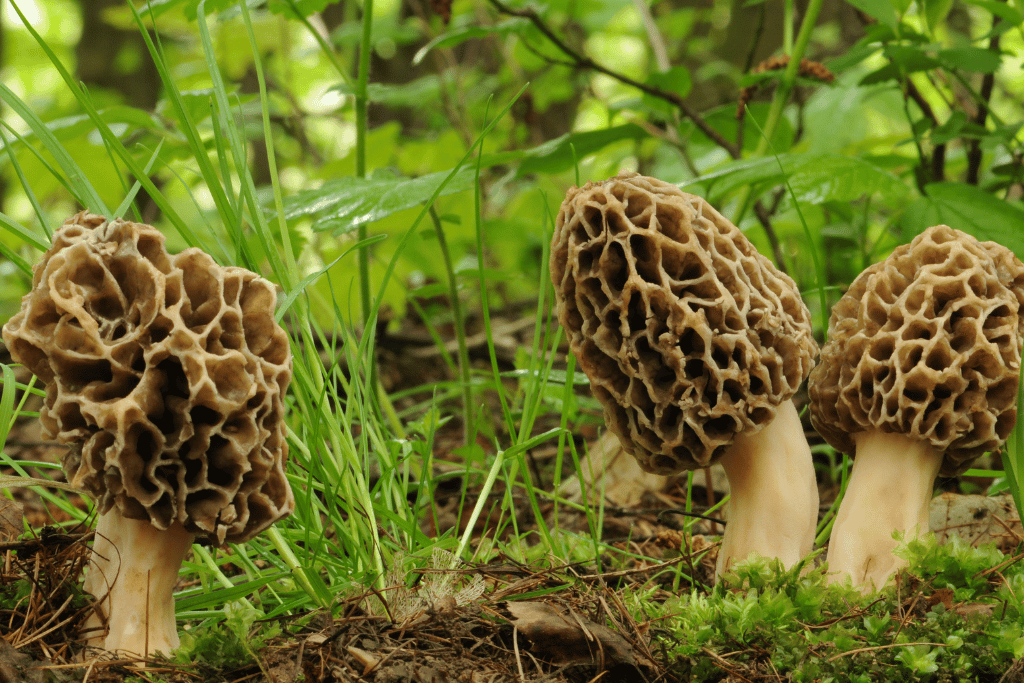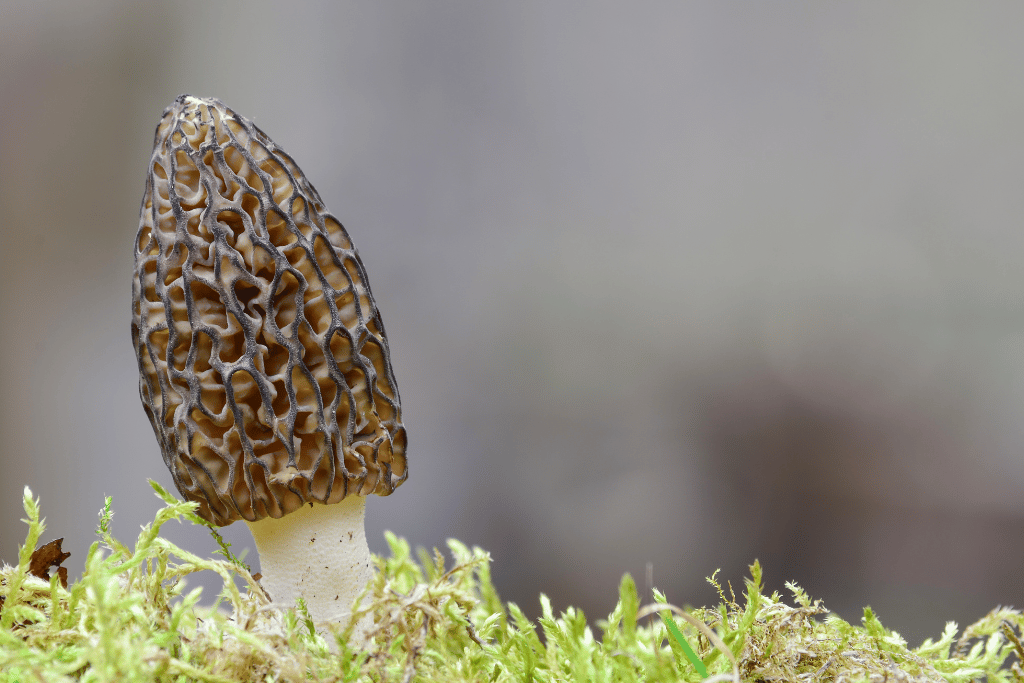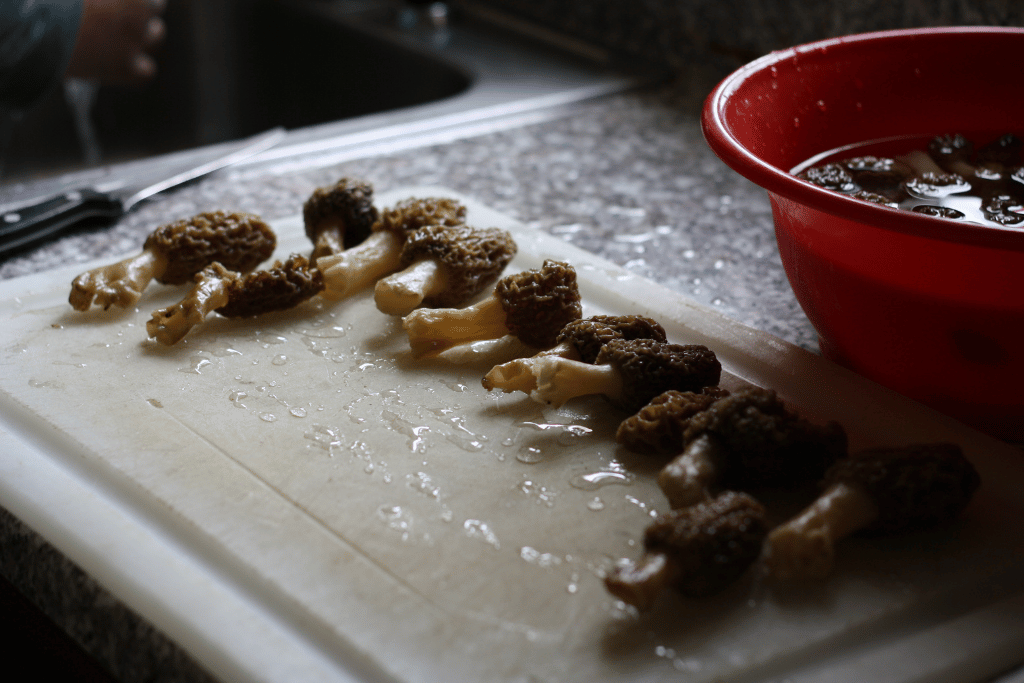
Morel mushrooms are a highly prized edible wild mushroom that is known for its delicious flavor and unique honeycomb-like appearance. Morel mushrooms are also known for their elusive nature, as they can be difficult to find and grow. One of the most common questions asked by morel hunters and growers is: How fast do morels grow?
Morel Mushroom Basics
Taxonomy and Classification
Morel mushrooms are members of the genus Morchella, which belongs to the family Morchellaceae. There are over 60 species of morel mushrooms found around the world, but the most common edible species are Morchella esculenta and Morchella deliciosa.
Ecological Preferences
Morel mushrooms are typically found in moist, well-drained soils in woodlands and forests. They are often associated with certain types of trees, such as elms, oaks, and poplars. Morel mushrooms also prefer to grow in areas that have been disturbed by fire or logging.
Culinary and Commercial Importance
Morel mushrooms are highly prized by chefs and gourmets for their unique flavor and texture. They can be eaten fresh, dried, or preserved. Morel mushrooms are also commercially valuable, and they are sold in many markets and restaurants.
The Morel Mushroom Life Cycle
Morel mushrooms have a complex life cycle that includes the following stages:
Spore dispersal: Morel mushrooms release their spores into the air, where they can travel long distances on the wind.
Germination: Spores that land in suitable conditions will germinate and produce mycelium.
Mycelium growth: Mycelium is a network of fungal threads that grows underground. Morel mycelium can persist in the soil for many years, even if it does not produce fruiting bodies.
Primordia formation: Primordia are the early stages of mushroom development. Primordia form when mycelium reacts to certain environmental cues, such as changes in temperature or moisture.
Mushroom fruiting: Once primordia have formed, they will develop into mature mushrooms. Morel mushrooms typically fruit in the spring, but they can also fruit in the summer and fall in some regions.
Factors That Influence Morel Growth Speed

The growth rate of morel mushrooms is influenced by a number of factors, including:
Environmental Factors
- Temperature: Morel mushrooms prefer to grow in cool temperatures. Ideal temperatures for morel growth range from 50 to 65 degrees Fahrenheit.
- Moisture: Morel mushrooms need moist soil to grow, but they do not tolerate waterlogged conditions.
- Light: Morel mushrooms prefer to grow in shaded areas.
Soil Conditions
- pH levels: Morel mushrooms prefer to grow in slightly acidic soils with pH levels between 6.0 and 7.0.
- Organic matter: Morel mushrooms benefit from soils that are rich in organic matter.
- Microbial activity: Morel mushrooms have a symbiotic relationship with certain types of soil microbes. These microbes help to break down organic matter and make it available to the morel mycelium.
Geographic Location:
The geographic location also plays a role in morel growth speed. Morel mushrooms are more common in some regions than others, and they tend to fruit earlier in warmer climates.
Human Intervention:
Human intervention, such as logging and forest management practices, can also affect morel growth. Morel mushrooms often fruit in areas that have been disturbed by human activity.
How Fast Do Morels Grow?
The growth rate of morel mushrooms varies depending on the factors listed above. In ideal conditions, morel mushrooms can grow from primordia to mature fruiting bodies in as little as 10 to 15 days. However, morel growth is often slower, and it can take several weeks for morel mushrooms to reach maturity.
Germination Phase
Timeframe: The morel spore germination phase typically takes 2 to 3 weeks.
Conditions: Morel spores need warm, moist conditions to germinate. Ideal temperatures for morel spore germination range from 60 to 70 degrees Fahrenheit.
Mycelium Growth
Rate: The rate of mycelium growth can vary depending on the environmental conditions. In ideal conditions, mycelium can grow at a rate of up to 1 inch per day. However, morel mycelium growth is often slower, and it can take several years for mycelium to establish itself in a new area.
Environmental Influences: The environmental factors that influence morel mycelium growth include temperature, moisture, and soil conditions. Morel mycelium prefers to grow in cool, moist soils that are rich in organic matter.
Primordia Formation
Timing: Primordia typically form in the spring, when the soil temperature reaches around 50 degrees Fahrenheit. However, primordia formation can also occur in the summer and fall in some regions.
Factors Affecting Speed: The factors that affect the speed of primordia formation include temperature, moisture, and light. Morel primordia form most quickly in cool, moist, shaded conditions.
Mushroom Fruiting
Duration: The duration of mushroom fruiting can vary depending on the environmental conditions. In ideal conditions, morel mushrooms can fruit in as little as 7 to 10 days. However, morel fruiting is often slower, and it can take several weeks for morel mushrooms to reach maturity.
Size of Harvest: The size of the morel harvest can vary depending on the size of the established mycelium colony and the environmental conditions. In ideal conditions, a well-established mycelium colony can produce a large harvest of morel mushrooms.
How Much Can Morels Grow Within A Day?

Morels can grow up to several inches in a day, but this is rare. Typically, morels will grow a few inches over the course of a week. The growth rate of morels depends on the weather conditions and the availability of nutrients.
On average, morels can grow anywhere from 0.1 to 0.5 inches (2.5 to 12.7 mm) per day during their peak growth period. However, it’s essential to note that this growth rate is a general estimate, and individual mushrooms can exhibit different growth rates based on their specific conditions.
What Is The Typical Lifespan Of A Morel Mushroom?

The typical lifespan of a morel mushroom (Morchella spp.) is relatively short-lived compared to many other fungi. Morels are highly sought after by foragers and gourmet chefs for their distinctive flavor and appearance. These mushrooms typically emerge in the spring, although their exact lifespan can vary depending on environmental conditions and species.
Morels typically begin their life as a small, rounded, and wrinkled structure known as a “pin.” As they mature, they elongate and develop their characteristic honeycomb-like cap. The prime harvesting time for morels is when they are still firm and their caps are fully developed but have not yet begun to open.
The lifespan of a morel mushroom can range from a few days to a couple of weeks. It’s a relatively brief period, and once a morel begins to open and release spores, it signals the end of its edible stage. Eventually, the mushroom will deteriorate, turning dark and slimy, and its spores will be dispersed into the environment to continue the fungal life cycle.
To maximize the harvest of morels, foragers and mushroom enthusiasts must be vigilant and time their foraging trips carefully to catch these delectable fungi at their peak. The ephemeral nature of morels adds to their allure, making them a culinary treasure that’s eagerly anticipated each spring.
When Do Morel Mushrooms Grow?

Morel mushrooms typically fruit in the spring, but they can also fruit in the summer and fall in some regions. The specific timing of morel fruiting varies depending on the geographic location and the climate.
Seasonal Timing
- Spring Morels: Spring morels are the most common and widely distributed type of morel mushroom. Spring morels typically fruit in April and May in the northern hemisphere.
- Summer Morels: Summer morels are less common than spring morels, but they can be found in some regions in the summer months. Summer morels typically fruit in June and July in the northern hemisphere.
- Fall Morels: Fall morels are the least common type of morel mushroom. Fall morels typically fruit in September and October in the northern hemisphere.
Geographic Variation
The geographic location also plays a role in the timing of morel fruiting. Morel mushrooms tend to fruit earlier in warmer climates and later in colder climates.
Impact of Climate Change
Climate change is also impacting the timing and distribution of morel mushrooms. In some regions, morel fruiting is occurring earlier in the spring due to warmer temperatures. Climate change is also causing morel mushrooms to expand their range into new areas.
How Do Morel Mushrooms Grow If They Are Not Cultivated?
Morel mushrooms are typically found growing in the wild and are considered mycorrhizal fungi. This means they have a symbiotic relationship with the roots of certain trees, often hardwoods like oak, ash, and elm. Morels tend to appear in the spring or early summer when soil temperatures rise and moisture levels are right. They can be elusive and are often found in forests, near decaying trees, or in disturbed areas with rich organic matter.
How to Cultivate Morel Mushrooms

Challenges and Success Rates
Cultivating morel mushrooms is challenging, but it is possible. Success rates vary, but some growers are able to produce consistent yields of morel mushrooms.
Steps in Controlled Cultivation
The following steps are involved in controlled morel mushroom cultivation:
- Spore collection: Morel spores can be collected from wild morel mushrooms or purchased from a reputable supplier.
- Germination: Morel spores are germinated in a sterile environment on a nutrient-rich substrate.
- Mycelium growth: The germinated spores produce mycelium, which is grown on a substrate, such as hardwood sawdust or straw.
- Fruiting conditions: Once the mycelium has grown sufficiently, it is exposed to fruiting conditions, such as changes in temperature and humidity. If the fruiting conditions are correct, the mycelium will produce morel mushrooms.
Comparison to Wild Morel Growth
Cultivated morel mushrooms typically grow faster than wild morel mushrooms. This is because cultivated morel mushrooms are grown in ideal conditions and are not subject to the same environmental challenges as wild morel mushrooms.
How Long Does It Take For A Morel Mushroom To Grow If We Use Cultivation Methods?

Cultivating morel mushrooms is a challenging endeavor, as they have complex growth requirements and are not as easily cultivated as some other mushrooms like button mushrooms.
If using a spore-inoculated substrate, it can take several weeks to months for the mycelium (the fungal network) to colonize the substrate. After this, it may take another few weeks to a couple of months for the morel mushrooms to begin fruiting, depending on environmental conditions and the specific cultivation method used.
The exact timing can vary, and success is not guaranteed, making morel cultivation a pursuit for experienced mushroom enthusiasts.
Growing Morel Mushrooms Outdoors

Suitable outdoor locations for growing morel mushrooms include:
- Wooded areas with moist, well-drained soils
- Areas that have been disturbed by fire or logging
- Areas near certain types of trees, such as elms, oaks, and poplars
Creating an Outdoor Morel Bed:
To create an outdoor morel bed, you will need to:
- Prepare the soil by removing any debris and adding organic matter, such as compost or wood chips.
- Inoculate the soil with morel spores or mycelium.
- Mulch the bed with a layer of straw or wood chips.
- Water the bed regularly, but avoid overwatering.
Patience and Timing
It can take several years for morel mushrooms to fruit in an outdoor bed. Be patient and keep the bed moist during the growing season.
Harvesting from Outdoor Beds
Morel mushrooms are typically harvested when they are young and immature. To harvest a morel mushroom, gently twist it out of the ground. Be careful not to disturb the mycelium.
Growing Morel Mushrooms Indoors

An indoor morel mushroom growing setup typically includes the following:
- Containers or bags
- Substrate
- Temperature and humidity control
Containers or Bags
Morel mushrooms can be grown in a variety of containers or bags, such as plastic buckets, grow bags, or mushroom kits.
Substrate
The substrate is the material that the morel mycelium will grow on. Suitable substrates for morel mushroom cultivation include hardwood sawdust, straw, and a combination of the two.
Temperature and Humidity Control
Morel mushrooms prefer to grow in cool, moist conditions. Ideal temperatures for indoor morel mushroom cultivation range from 50 to 65 degrees Fahrenheit. Ideal humidity levels for indoor morel mushroom cultivation range from 70 to 90 percent.
Spore Inoculation and Mycelium Growth
To inoculate the substrate with morel spores or mycelium, you will need to:
- Sterilize the substrate by steaming or autoclaving it.
- Inoculate the substrate with morel spores or mycelium.
- Incubate the substrate in a sterile environment until the mycelium is fully established.
Mimicking Natural Conditions
Once the mycelium is fully established, you will need to mimic natural conditions to induce fruiting. This can be done by exposing the mycelium to changes in temperature and humidity. You can also try using a light cycle to mimic the natural day/night cycle.
Harvesting Indoor Morels
Morel mushrooms are typically harvested when they are young and immature. To harvest an indoor morel mushroom, gently twist it out of the growing medium. Be careful not to disturb the mycelium.
Harvesting Morel Mushrooms Sustainably
Methods and Tools:
Morel mushrooms can be harvested using a variety of methods and tools. Some common harvesting methods include:
- Gently twisting the mushroom out of the ground
- Using a sharp knife to cut the mushroom at the base of the stem
- Using a mushroom picker to harvest the mushroom without damaging the mycelium
Sustainable Harvesting Practices
To harvest morel mushrooms sustainably, it is important to follow these practices:
- Only harvest young, immature mushrooms.
- Leave some mushrooms behind to produce spores. Moreover, here’s how you can store mushroom spores.
- Do not disturb the mycelium.
- Be careful not to damage the surrounding vegetation.
Conclusion
The growth rate of morel mushrooms is a topic of curiosity for many. So, how fast do morels grow? Well, it’s important to remember that morel growth is influenced by various factors like temperature, moisture, and soil conditions.
Typically, morels can appear relatively quickly, sometimes within two weeks or less, provided the right conditions are met. However, the exact speed of their growth can vary.
FAQS
In which regions are morels most abundant?
Morels are found all over the world, but they are most abundant in temperate regions with moist, well-drained soil. In North America, they are common in the eastern and midwestern United States, as well as in southern Canada. In Europe, they are found in many countries, including France, Germany, Italy, and the United Kingdom. Morels are also found in Australia, New Zealand, and Asia.
Do morels reappear in the same location?
Yes, morels can reappear in the same location year after year. However, they are unpredictable and can be difficult to find. Morels are most likely to grow in areas that have been disturbed, such as burned forests or old logging sites. They are also often found near trees, such as oak, elm, and ash.
Is it possible to cultivate morels?
Yes, it is possible to cultivate morels, but it is difficult. Morels require specific conditions to grow, and they are susceptible to pests and diseases. However, there are a few methods that can be used to cultivate morels, such as the spore inoculation method and the sclerotia planting method.
Can you accelerate the growth of morels overnight?
No, it is not possible to accelerate the growth of morels overnight. Morels grow slowly, and they require specific conditions to do so. There are no known methods that can be used to speed up the growth of morels.
Are morels poisonous?
Morel mushrooms are a popular edible mushroom, but they are also poisonous if eaten raw. It is important to cook morels thoroughly before eating them. Morels can be cooked in a variety of ways, such as frying, sautéing, and grilling.
Morel mushrooms are a good source of protein, fiber, and vitamins. They are also low in calories and fat. Morels are a healthy and delicious addition to any meal.




Pingback: What's the growth rate of morel mushrooms in the wild? - Grow My Own Health Food